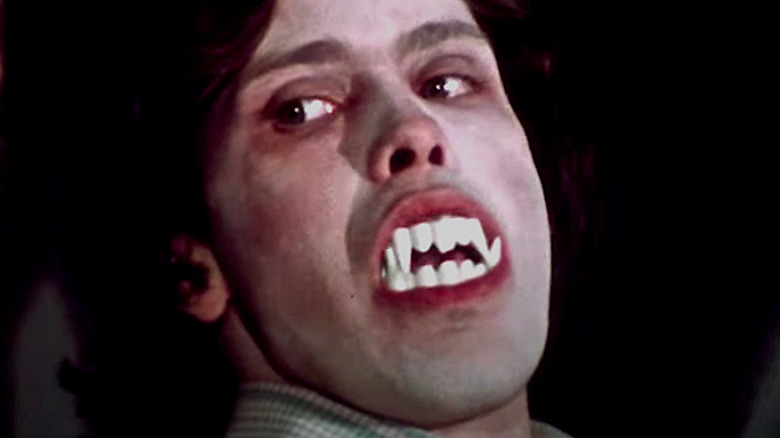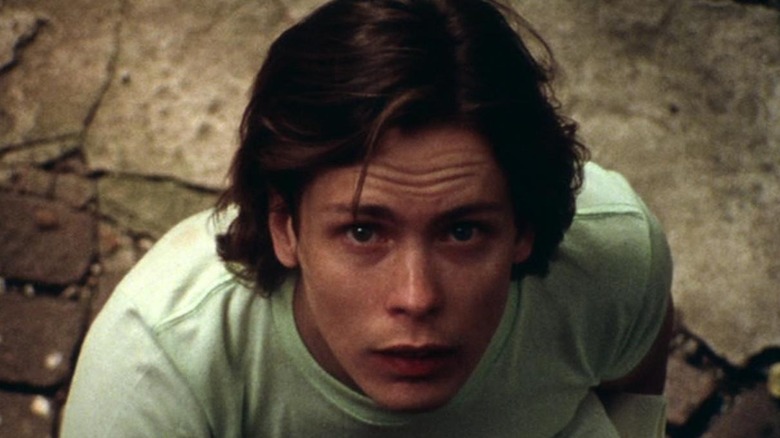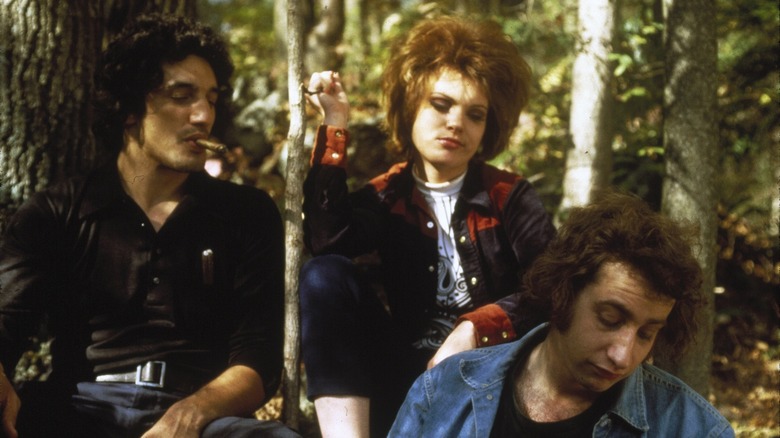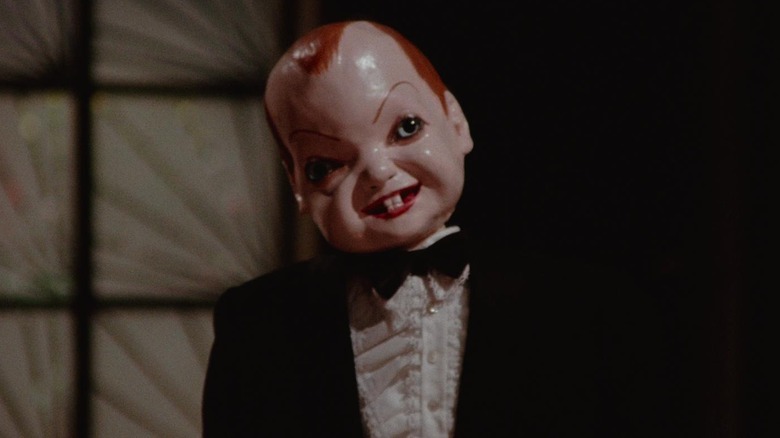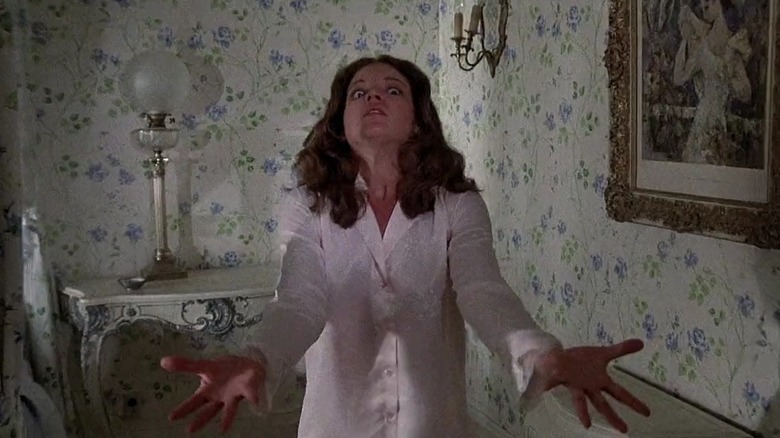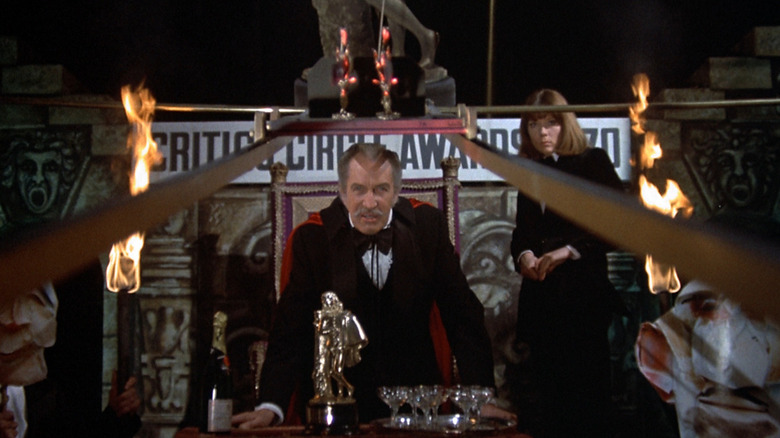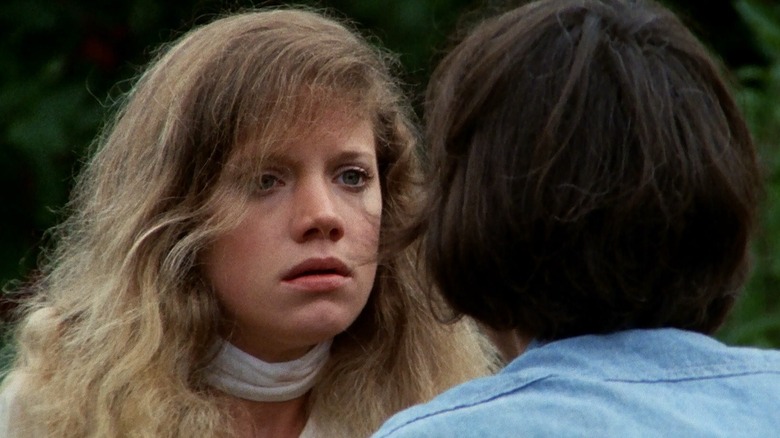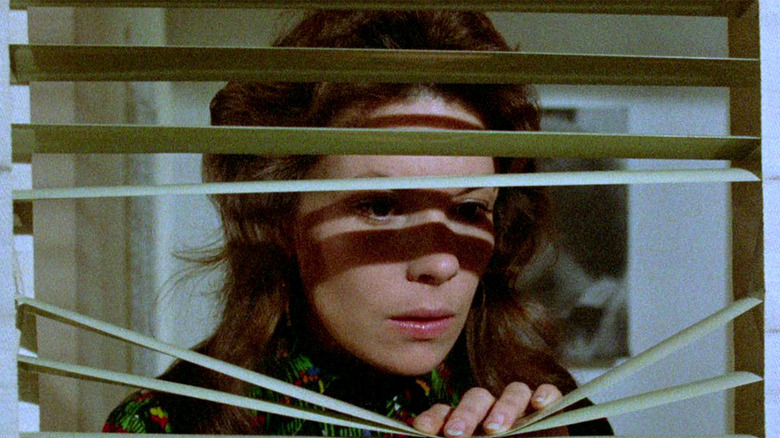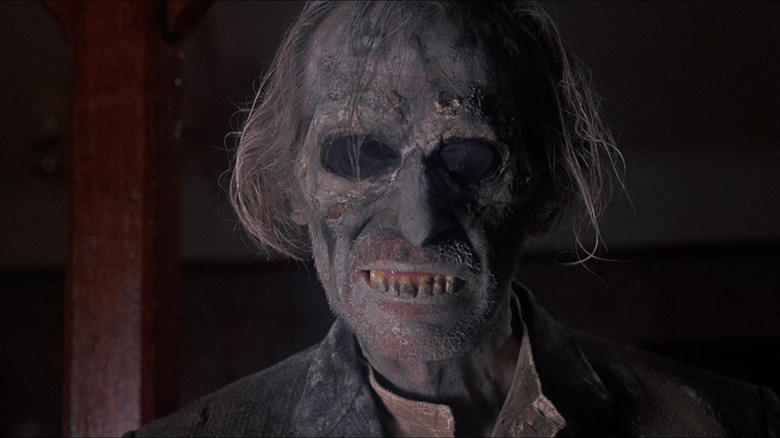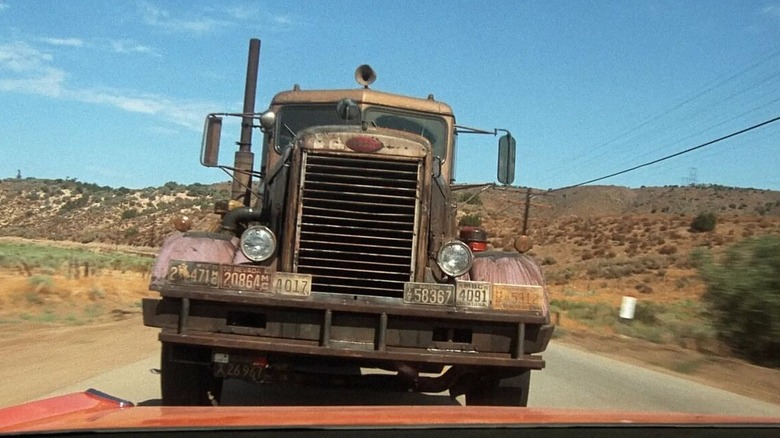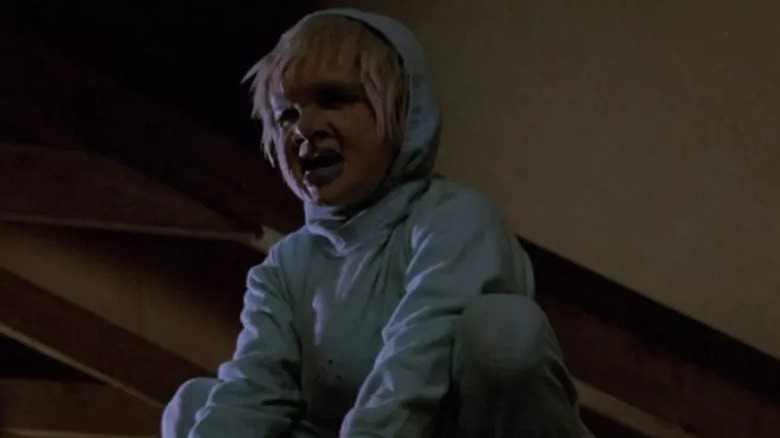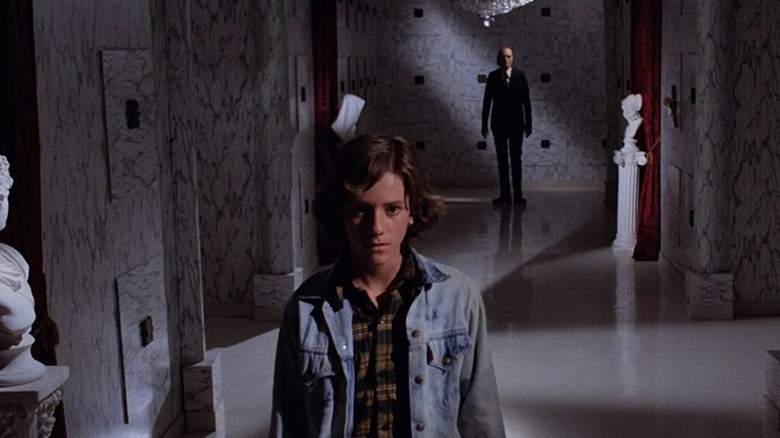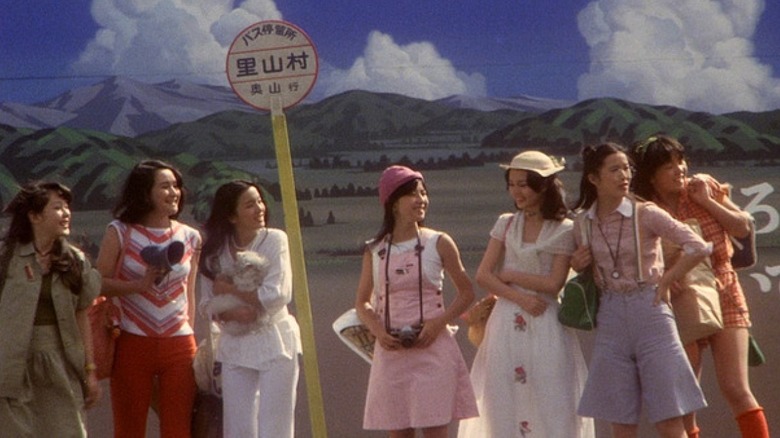Underrated '70s Horror Movies You Should Watch Next
If you're looking for a good horror movie, the 1970s are a great place to start. Boasting such beloved classics as "Halloween," "Carrie," "Suspiria," and "Alien," the '70s are commonly seen as one of the most revolutionary decades for the genre. With previously strict rules regarding cinematic depictions of horror growing lax by the late 1960s (per NPR), '70s horror movies pushed the envelope further than audiences had ever thought possible, crafting some of the most terrifying films imaginable.
Even now, decades later, many of the most famous horror movies of the 1970s continue to rank as some of the scariest movies ever made. It's the era that saw an influx of slasher movies, as well as mainstream hits like "The Exorcist" and "Jaws," which dominated worldwide box offices everywhere (per IndieWire). At the same time, lower-budget exploitation films continued to rise throughout the U.S., some of which — like "The Hills Have Eyes" and "The Amityville Horror" — became cult hits in subsequent decades.
For as many well-known horror movies there are in the 1970s, there are also a ton of films that are frequently overlooked by contemporary audiences today. From Italian giallo films to little-known early works from acclaimed genre directors like Wes Craven, Brian De Palma, and David Cronenberg, here are some of the most criminally underrated horror movies of the 1970s that we recommend checking out.
Warning: some spoilers below.
Martin
George A. Romero completely reinvented the zombie film with his seminal 1968 debut, "Night of the Living Dead," which established him as one of the definitive faces of horror for the next two decades. While he's undoubtedly best known for his zombie movies, Romero also touched upon the vampire sub-genre in his under-appreciated 1976 psychological horror film, "Martin."
"Martin" follows a young man (John Amplas), who believes himself to be a vampire. Moving in with his elderly, ill-tempered cousin in a small Pennsylvanian town, Martin tries his best to fight his inner demonic urges. A brilliant and contemporary take on the vampire myth, "Martin" is a horror movie that has aged well, feeling like a spiritual precursor to similarly-veined vampire films like "Vampire's Kiss" and Guillermo del Toro's "Cronos."
The film earned predominantly positive reviews from critics, with Variety writing that Romero "has inserted some sepia-toned flashback scenes of 'Martin' in Rumania that are extraordinarily evocative, and his direction of the victimization scenes shows a definite flair for suspense." As reported by PopMatters, Romero himself even named it his personal favorite film of his career. Most recently, Time Out included it as number 87 on their list of the "100 Best Horror Films."
The Last House on the Left
The following film includes depictions of sexual assault and violence.
It's fitting that the 1972 directorial debut of Wes Craven was a horror film, seeing as how intrinsically tied to the genre the director would grow to be. "The Last House on the Left" follows two teenage girls, who are abducted and horrifically attacked by a gang of psychopathic fugitives. Venturing into the woods, the gang unknowingly come upon one of the girl's parents, who agree to shelter them for the night. Little do they know, the parents have a plan to take swift, brutal revenge for the girls' assault.
An exploitation film based on Ingmar Bergman's "The Virgin Spring" (per The Guardian), "The Last House on the Left" left audiences practically speechless upon its original release. According to Steven Jay Schneider's essay "The Legacy of 'Last House on the Left'," Craven earned both praise and criticism for his unflinching approach to the horror genre (per "Horror at the Drive-In: Essays in Popular Americana"). The film's realistic portrayal of violence led to its innovative marketing tagline: "Can a movie go too far?" The gambit worked, as "The Last House on the Left" grossed $3 million against its meager $87,000 budget (per The Numbers).
Reviews of the film have steadily improved over the years, with even the most apprehensive critics noting just how influential it truly was. In his book "Leonard Maltin's 2014 Movie Guide," respected film critic Leonard Maltin called the movie "Repellent but admittedly powerful and (for better or worse) influential horror shocker." It was nominated for AFI's 100 Years ... 100 Thrills list, and was remade into a more financially successful reboot in 2009.
If you or anyone you know has been a victim of sexual assault, help is available. Visit the Rape, Abuse & Incest National Network website or contact RAINN's National Helpline at 1-800-656-HOPE (4673).
Deep Red
Few names are as synonymous with the Italian giallo sub-genre as Dario Argento, the filmmaker behind such acclaimed horror films as "The Bird with the Crystal Plumage" and "Suspiria." As incredible and terrifying as "Suspiria" is though, many of Argento's other films continue to rank as some of the scariest and most underrated horror movies of all time, including his 1975 mystery film, "Deep Red."
After a psychic is murdered by an unknown serial killer she detected in a crowd of people, an English jazz pianist (David Hemmings) begins looking into the killer's past murders. As he continues his investigation, he finds every would-be witness being killed off, leaving him to wonder how the killer is able to predict his every move.
Today, "Deep Red" is considered one of the best giallo films released in Italy during the peak of the genre's popularity. "Operating under the principle that a moving camera is always better than a static one ... 'Deep Red' showcases the technical bravado and loopy shock tactics that made Argento famous," said The AV Club's Keith Phipps. Noteworthy fans of the film include Quentin Tarantino, who spoke at PaleyFest NY 2020 about seeing Argento's classic as a teenager: "It's these horrendous murders and horrendous kills one after another with just complete sadism. ... That was like, 'Wow this movie is really tough stuff,' but it was thrilling. It was absolutely thrilling" (per IndieWire).
The Fury
Thanks to films like "Carrie" and "Phantom of the Paradise," Brian De Palma became one of the definitive names of mainstream horror by the end of the 1970s. De Palma followed up his 1976 box office hit "Carrie" with "The Fury," one of his most overlooked contributions to the genre, which was also one of the first times he worked with a larger budget and more well-known cast of actors (per Den of Geek).
Peter (Kirk Douglas) is an ex-CIA agent attempting to rescue his psychic son from the clutches of an unscrupulous former colleague (John Cassavetes), who wants to use him for shadowy government operations. To help free his son, Peter asks for the assistance from a young high school student (Amy Irving) with similar telekinetic abilities, who is only now just beginning to understand the limits of her mental powers.
While "The Fury" may not be as popular a De Palma film as "Carrie," it's still an enthralling horror movie that blends the psychic aspects of "Carrie" with fears of government paranoia that were depicted in De Palma's later work "Blow Out." Critics praised "The Fury" for its tone, performances, and John Williams' booming score. Philip French wrote for The Guardian that "The polished melodrama is enhanced by John Williams's score and blood flows from the start in characteristic fashion. ... De Palma locates his bizarre events in a plausible, sharply observed world."
Theater of Blood
Horror icon Vincent Price may be more usually associated with his earlier career-defining roles in the horror films of the '50s and '60s. However, by 1970, Price had also managed to stay in vogue with more modern, satirical horror films that took advantage of his on-screen status as a face of the genre. One of the foremost among these was "Theater of Blood," a 1973 horror/dark comedy that finds Shakespearean actor Edward Lionheart (Price) seeking revenge against a group of theater critics, who have lambasted his performances throughout his career.
Using many of Shakespeare's most violent plays as inspiration, Lionheart begins picking the critics off one by one in an absurd, overly theatrical manner. It's a bit of a silly concept, but Price brilliantly plays the leading role with enough menace and camp to transform the film from a mere footnote in his career to one of the absolute highlights in his lengthy filmography.
"Theater of Blood" is often considered one of the best films of Price's career, since it shows his versatility as an actor able to blend horror and comedy in one well-rounded role. Philip French of The Guardian put it best, saying the movie contains "arguably Price's finest single performance, certainly the one that called on all his varied talents as a comedian, aesthete, mellifluous speaker of verse, old-fashioned barnstormer and exponent of horror."
Let's Scare Jessica to Death
An unsung classic in the psychological horror genre, 1971's "Let's Scare to Jessica to Death" follows a woman fresh out of a mental health clinic named Jessica (Zohra Lampert), who moves to a remote farm in New York with her husband and a close friend. Upon moving into her new home, Jessica begins to have a series of disturbing, possibly supernatural experiences that leave her slowly questioning her sanity.
Combining the more psychological horror elements found in novels like "The Turn of the Screw" and "The Haunting of Hill House," director John Hancock managed to create a film with a distinct air of mystery that leaves plenty of room for audience interpretation. Initially released in 1971, "Let's Scare Jessica to Death" left most critics divided, as some felt alienated by the ambiguities surrounding the film's nature and almost illusory tone.
Over the years, however, it's gone on to become a beloved cult classic among modern horror fans, with Time Out and the Chicago Film Critics Association ranking it on their lists for the 100 scariest films of all time. "'Jessica' did in many ways serve as a forerunner for what would come later, as filmmakers like David Lynch would delve into dreamscapes that refused to sustain themselves explicitly in cohesive narratives," said Syfy's Sara Century. According to Trailers From Hell, "The Twilight Zone" creator Rod Serling called the movie one of "the most frightening films he'd ever seen in his life."
Sisters
Another underrated Brian De Palma film, 1972's "Sisters" marks his first foray into horror. The film follows an ambitious, small-time reporter (Jennifer Salt), who witnesses a murder in the Manhattan apartment next to hers. As she investigates the killing, she comes face to face with a sinister conspiracy involving conjoined twins (both of whom are played by Margot Kidder), who have recently been separated from each other.
Channeling his love for the movies of Alfred Hitchcock, De Palma crafts a palpably suspenseful and intriguing film that builds up an intense air of mystery, which culminates in a wild, shocking conclusion. It's a movie on par with the work of the Master of Suspense himself, elevating De Palma to new heights as a director. After making dark comedies like "Hi, Mom!" and "Greetings" (Robert De Niro's feature debut), De Palma found a new genre that he was comfortable working in with "Sisters." Carrie Rickey called this "the foundational film in his career" in an essay for Criterion, as De Palma later went on to helm such horror hits as "Carrie," "The Fury," and "Dressed to Kill."
Warmly received by critics upon its 1972 release, retrospective reviews of "Sisters" have only continued to improve. Justin Chang of The Los Angeles Times named it one of De Palma's most underrated works, writing, "De Palma's choice of subject matter couldn't have been more appropriate: With this film he effectively conjoined himself to Hitchcock, announcing himself as a skillful mimic with a mischievous side all his own."
Tales from the Crypt
"Tales from the Crypt" may be more synonymous with its later HBO series, but in the early 1970s, a feature-length adaptation was the first to bring EC Comics' iconic horror comic to the screen (per IMDb). Faithfully based on EC's horror title of the same name, Freddie Francis' 1972 "Tales from the Crypt" takes several of the comic's best stories and presents them in an anthology format, as the Crypt Keeper (Ralph Richardson) explains to a group of people the manner in which they'll die.
Dark, grim, and gritty, "Tales from the Crypt" lacks the inherent dark humor found in the HBO take on the comic, but still manages to deliver one of the most enjoyable anthology movies of the 1970s. This is in part due to its ensemble cast of stars like Joan Collins, Richard Greene, Ian Hendry, and accomplished horror actor Peter Cushing.
Released during a time when the horror genre was seeing an influx in anthology films (many of them weird and ridiculous), "Tales from the Crypt" was one of the greatest and most memorable horror movies released at the time, receiving positive reviews in 1972. Famed film critic Roger Ebert lauded "Tales from the Crypt" for its faithfulness in recreating the look, format, and tone of the original comics: "It's put together something like the comic books, with the old Crypt Keeper acting as host and narrator ... the visuals and decor have been planned in bright basic colors and gray, so they look something like comic panel."
Duel
In the world of horror, Steven Spielberg is most commonly associated with his unforgettable breakout film "Jaws." However, four years before crafting the movie that would make countless people terrified of the ocean, young Spielberg made his feature debut with "Duel," a tense, suspenseful made-for-TV horror film.
Adapted from a short story by influential horror writer Richard Matheson, "Duel" follows a businessman (Dennis Weaver) traveling through the Mojave Desert, who unknowingly angers the driver of a fume-spewing tractor-trailer. Before long, the driver of the trailer begins pursuing the businessman in a lengthy chase across the sparsely populated desert highways.
Reminiscent of "Jaws" in terms of its faceless and unseen antagonist and its cat-and-mouse style second act, "Duel" gave Spielberg his start in Hollywood. While it continues to rank as one of Spielberg's most underrated works, it has gotten almost entirely positive reviews, and is now considered a cult classic. It received a Golden Globe nomination in 1972 for Best Movie Made for TV and was included on Bravo's 100 Scariest Movie Moments.
The Brood
David Cronenberg will forever be known as the master of body horror, thanks to his work on films like "The Brood," "Scanners," and "Videodrome." In "The Brood," Cronenberg delivered one of the most defining contributions to body horror, pioneering the sub-genre and pushing it in memorably disgusting new directions.
Amidst a series of brutal murders by what look like parka-clad demonic children, a man (Art Hindle) tries to contact his wife, who's receiving experimental treatments from a renowned yet controversial psychotherapist (Oliver Reed). Mixing elements of familial drama with aspects of slasher and body horror films, "The Brood" is one of the movies that defined the trajectory of Cronenberg's career. The popularity of the movie helped the young Cronenberg gain enough exposure to helm later body horror films in the next two decades, each more shocking and stomach-churning than the last (per RogerEbert.com).
At the time of its release in 1979, "The Brood" earned generally positive reviews. However, as Cronenberg became an increasingly well-known director behind such films as "The Fly" and thrillers like "A History of Violence," "The Brood" — like many of his body horror films — became something of a cult classic. "Combining intellectual, metaphorical and visceral shocks, and building to one of the most unforgettable and queasiest finales in horror cinema, 'The Brood' stands out even within the outré Cronenberg oeuvre," said IndieWire.
Phantasm
One of the most popular cult classic horror films of the 1970s, "Phantasm" is almost a movie too weird to put into words. A teenage boy (A. Michael Baldwin) and his older brother (Bill Thornbury) investigate a mysterious, towering mortician known only as the Tall Man (Angus Scrimm). They soon discover he's actually shrinking the bodies of the dead down and re-animating them into obedient zombies, transporting them to his alien home world to be used as slave labor.
As bizarre as the premise sounds, "Phantasm" is a surprisingly skillful horror movie that mixes absurd concepts with genuine scares. The first entry in the "Phantasm" series, it's not a franchise with as much name-recognition as the "Nightmare on Elm Street" or "Friday the 13th" series, but it's still an incredibly unique and memorably strange horror movie that needs to be seen to be believed (at least the first one, anyway).
Initial reviews for the film in 1979 were mostly mixed, with criticism aimed at the movie's dreamlike images and loose, borderline surreal narrative (both of which are now considered two of the movie's greatest strengths). Nowadays, however, it's considered one of the greatest horror movies of all time, influencing later horror classics like "A Nightmare on Elm Street" (per USA Today) and inspiring the character of Captain Phasma in the "Star Wars" sequel trilogy, according to Entertainment Weekly. Bravo even included the movie on their list for The 100 Scariest Movie Moments.
House
An indescribably strange movie that eludes proper description, the 1977 Japanese horror film "House" follows a group of young women who travel to a friend's isolated country home, where they get consumed by the house one person at a time. While that may seem like a simple or straightforward premise, the film is anything but, as it contains extended hallucinatory sequences. These scenes are extremely weird in nature and include everyday household items like lamps and pianos devouring the young women whole.
Part dark comedy, part horror, "House" was a boundary-pushing experimental film that is often seen as one of the most original horror films ever made. It's been admired for taking the haunted house concept and turning it completely on its head, and is now seen as beloved cult classic of Japanese horror films. Publications like Screen Rant, Bloody Disgusting, and Rotten Tomatoes have each included it on their list of the best Japanese horror films and/or best horror films of all time.
Jeff Shannon summed it up for The Seattle Times: "'House' turns into a horror-fantasy comedy that grows increasingly absurd as the body-count rises, provoking more laughs than fear with over-the-top scenes involving severed limbs, a ravenous piano, attacking mattresses and a cat with telekinetic powers." There's simply nothing else quite like it.
